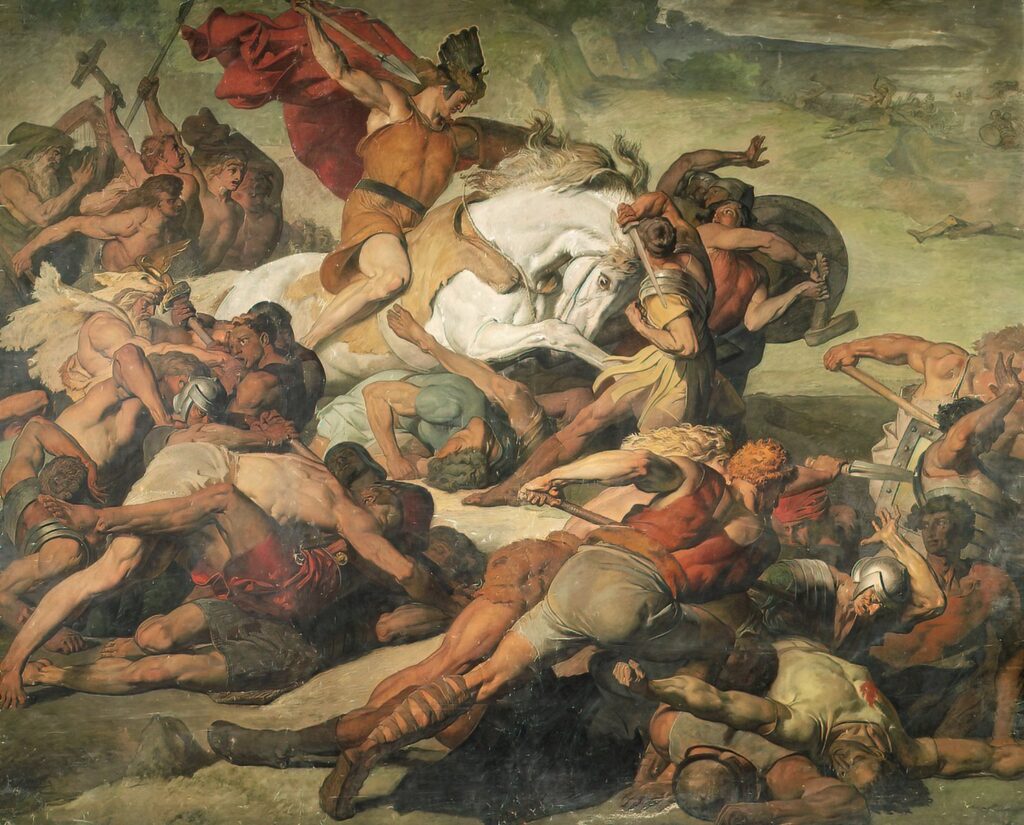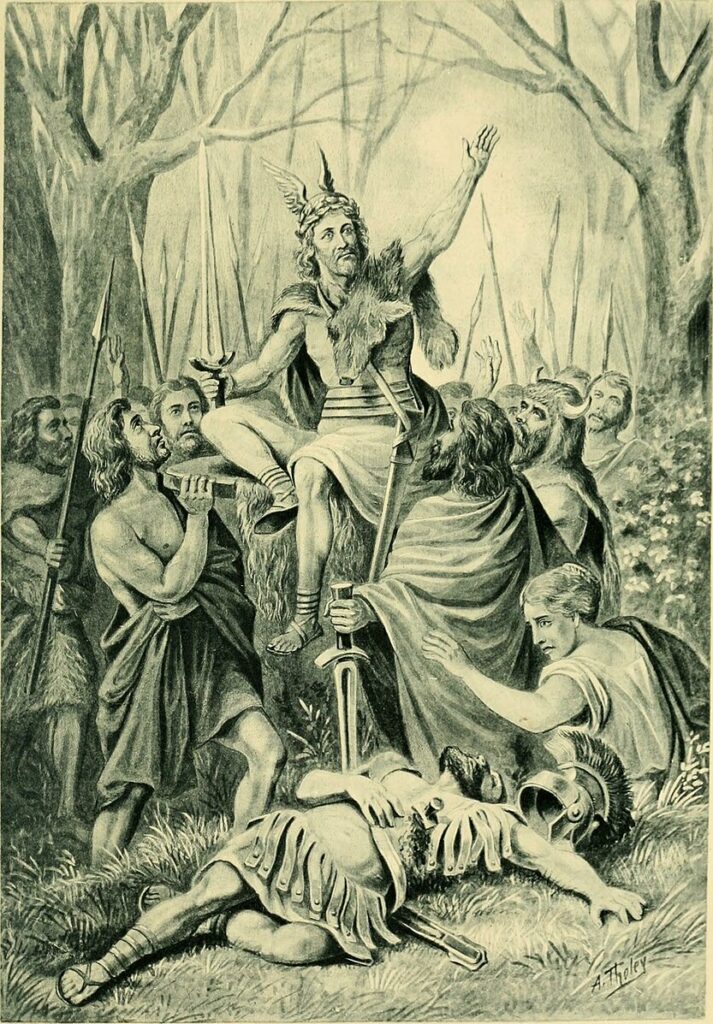The Battle of Teutoburg Forest is perhaps one of the most consequential battles in the history of the Western world. Also known as the Varian Disaster, the battle saw Germanic tribesmen led by a Roman-trained general decimate three legions of Roman soldiers.
A group that the Romans deemed barbaric and uncivilized would use guerrilla warfare and insider information to defeat the most powerful military in the world. Their victory would halt Roman expansion and dictate the future of Europe. It would be immortalized in German myth for centuries.

An Expanding Empire
The Roman Empire was the most powerful force in the world by the 1st century BCE. It rapidly expanded and conquered neighboring regions.
The legions of Rome expanded across far-reaching swathes of land. They encompassed a wider variety of people. The ability to occupy the land and expand further required that non-Roman citizens be admitted into the military forces and trained.
Although non-Romans could not join the Roman legions, military forces called auxiliaries were formed so that the military could continue to grow. Roman military forces would provide training to these auxiliary forces. They would then march with the Roman legions or be dispatched to regions outside of their original homeland.
This had the dual benefit of assisting with the process of Romanization by letting other non-Romans help assimilate new people into the multi-ethnic empire.
Auxiliary Training
It is through this auxiliary program that Arminius of the Germanic Cherusci tribe first gained his military training.
Arminius was a Cherusci prince who grew up integrated into the Roman Empire, even gaining Roman citizenship. He received military training as an auxiliary and became intimately familiar with Roman tactics.
In 4 CE, he was given command of auxiliary forces. In 8 CE, he returned to Germania to serve under the regional governor Publius Quinctilius Varus.
Varus was a Roman politician and general who had previously ruled over a region of Africa. His strict rule over Roman-deemed heretics defined his political legacy. Emperor Augustus made him the governor of Germania in 7 CE.
The emperor encouraged Roman expansion in the region. Perhaps expecting a similar level of cunning and heavy-handedness that Varus had demonstrated in Africa.
By 8 CE, Arminius warned Varus of potential revolts from local Germanic tribes. He quickly began to prepare his legions in response.
Arminius’ Betrayal
Varus’ fatal mistake in this campaign would be trusting Arminius despite warnings from other Roman and Germanic leaders. Although the truth remains unclear, it is rumored that Arminius organized the rumors of rebellion himself by reaching out to the various Germanic tribes.
As prince of the Cherusci, he likely wanted to ensure that he would be king of his people. He likely wanted to unite the tribes, and he assumed that disrupting Roman advances was a way to prove himself worthy of the title.
So after giving Varus a warning of a rumored insurrection, Arminius joined with his men as the Roman forces set out in force, an estimated 15,000 troops in all, to put down the Germanic rebellion.
Following Arminius’ suggestion, the forces made their way deep into rebel territory, miles from any established base or road. The Roman forces slowly made their way through boggy forests as a storm worsened conditions.
This caused the forces to be spread out over nearly eight miles as the normally organized soldiers struggled to keep their footing.

Roman Defeat
It was when the Romans were at their least organized that the Germanic forces struck.
Roman legions were used to fighting in open fields. They were typically highly organized. But fighting in the stormy forest caught them off-guard. The Germans descended on the forces. They started with ranged attacks that hindered a number of the Roman soldiers.
Once it became clear that they could do little to assist those who were injured, the Germans began closing in on the wounded and attacking the forces at close range. As the Romans were slowly picked off, the forces kept pressing on towards a Roman base nearly 60 miles away. They were hoping to reach safety and reinforcements before their forces fell apart.
But by the third day, the remaining forces were trapped by Germanic attackers in a narrow passage. They were decimated.
Using Arminius’ knowledge of Roman tactics and guerrilla tactics, the Germans easily defeated the Roman legions. They built angled walls to disrupt Roman formations and redirected the forces through dark, stormy, and boggy terrain.
This allowed the Germans to dictate the terms of the engagement. They were able to destroy the dominant military superpower in the world.
Once they realized that they were defeated, rather than risk capture and torture at the hands of Germanic tribesmen, Varus, and other Roman officers committed suicide by falling on their swords in typical Roman fashion.
Varus’ Legacy Destroyed
Very few Roman soldiers managed to escape the massacre. As they made their way back to Rome, they delivered the news which rocked Roman society.
The emperor, Augustus, cast out the Gauls and Germans in Rome out of fear of further disruption. The normally composed leader was said to have torn his clothes and cursed Varus. He demanded that Varus return his legions to him.
The emperor fell into a depression for months following the battle, reflecting the anger and grief felt by the families of the soldiers who were felled.
Varus’ reputation was destroyed. Previously an esteemed statesman, statues of Varus were vandalized and destroyed in Rome.
His son, an aspiring politician, had his career ruined. The associates who had assisted him throughout his career were shamed for having supported him.
News of the defeat would also shake the emperor himself. Upon hearing of the defeat, Augustus slipped into a depression for months. An astounding statistic is that casualties of the battle were so high that nearly 10% of the entire Roman army was defeated within three days.
Avenging the Legions
Roman forces would return to the site of the battle six years later and find a gruesome sight. The Germans had gathered anything of worth, such as coins or precious metal, and what remained was tragic.
Thousands of skeletons littered the region. They had been picked clean by local wildlife or decayed over time. They were surrounded by broken swords and armor.
Skulls were nailed to trees or split open on the ground where soldiers had been killed. Altars, where kidnapped soldiers were sacrificed by Germans, were still visible. The Roman general leading the expedition, Germanicus, had his men inter as many skeletons as they could before chasing Arminius deep into Germanic territory to avenge their fallen comrades.
These excursions resulted in Roman forces locating two out of three legionary standards lost during the battle. The third was recovered during later Roman excursions. As late as 41 CE, Roman soldiers would continue to rescue imprisoned legionnaires held in captivity from the battle.
Although the Romans ultimately failed to catch their target during Germanicus’ campaign beyond the Rhine, Arminius would be felled by conflict arising from his growing power in 21 CE. His coalition was united in defeating the Romans.
But when other Germanic leaders felt he had accumulated too much power, Arminius was killed by those closest to him.
Arminius: German Folk Hero
The German victory over the Roman legions shattered the perception that the Roman army was invincible. It halted the expansion of Rome into Eastern Europe.
It also served Arminius well. It led to his rule over a new coalition of Germanic tribes in the region for nearly two decades and his eventual incorporation into Germanic national myth.
German histories would tell of the hero who repelled the Roman empire. They renamed him Hermann to align with Germanic naming conventions since his original tribal name was lost to time.
A statue of Arminius was later erected near the battlefield. This would be the largest monument in the world until the dedication of the Statue of Liberty.
The Battle of Teutoburg Forest undeniably changed the way that European borders and cultures developed. It arguably reshaped world history in the process. By stopping Roman expansion at the Rhine, the battle delineated a clear line of Roman influence over the continent of Europe.
Within twenty years, Rome decided that the Rhine would be the boundary of Roman influence. Everything east of the river would remain Germanic.
Some scholars have argued that the Rhine was a logical boundary for Romans. This was due to logistical needs. Also because that battle did little to shape Roman expansion, since excursions continued in later decades.
While Romans still continued to explore east of the Rhine, most notably in the Marcomannic Wars, full-force Roman expansion ceased. Regardless of the truth, the battle is immortalized as an example of Germanic tribes defeating a tenth of the Roman army at the height of its power.
References
Bordewich, Fergus M. “The Ambush that Changed History.” Smithsonian Magazine, September 2006. https://www.smithsonianmag.com/history/the-ambush-that-changed-history-72636736/.
Grout, James. “The Battle of Teutoburg Forest.” Encyclopaedia Romana, 2023. https://penelope.uchicago.edu/~grout/encyclopaedia_romana/miscellanea/teutoburg/teutoburg.html.

